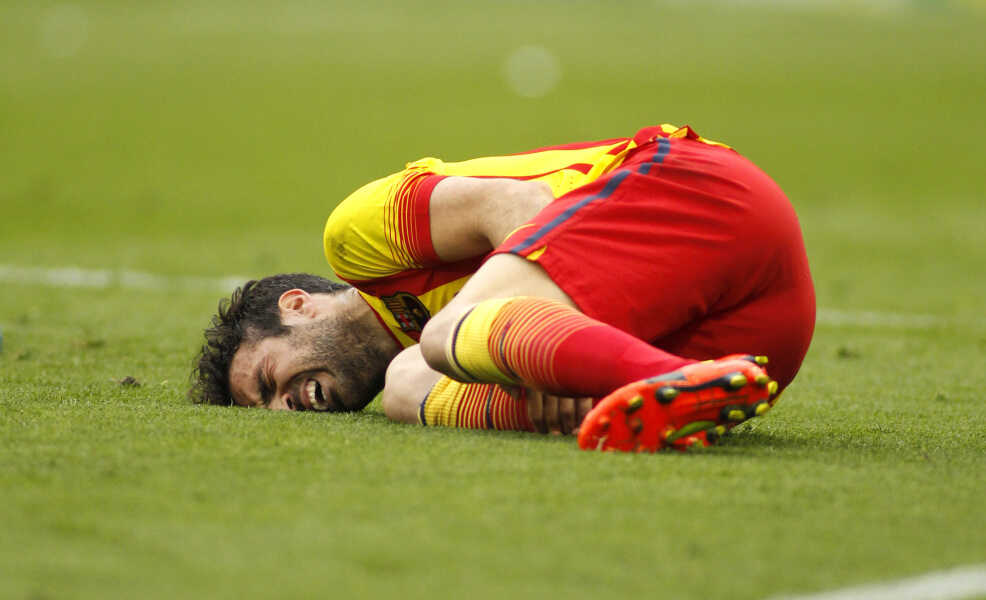
Even though football is not a dangerous sport, the nature of the sport means there are a lot of injuries, especially during the football season.
Football is a high-intensity sport with twists, turns and sudden sprints with frequent changes of direction on the pitch.
90 minutes of football can place a lot of strain on your knees, especially when wearing football boots with studs or blades.
Studs provide support and prevent you from slipping on grass. However, footwear can be the reason for many football-related knee injuries involving ligaments.
While studs prevent the player from slipping, the momentum from a tackle or a sharp turn is carried throughout the rest of the body, causing injuries to the knee meniscus or ligaments.
Anterior Cruciate Ligament or ACL Injury
Anterior Cruciate Ligament (ACL) injuries are the most serious football knee injuries. The ACL runs through the centre of the knee and connects the femur (thigh bone) to the tibia (shin bone) of the knee. The role of the ACL is to help stabilise the knee joint during different movements.
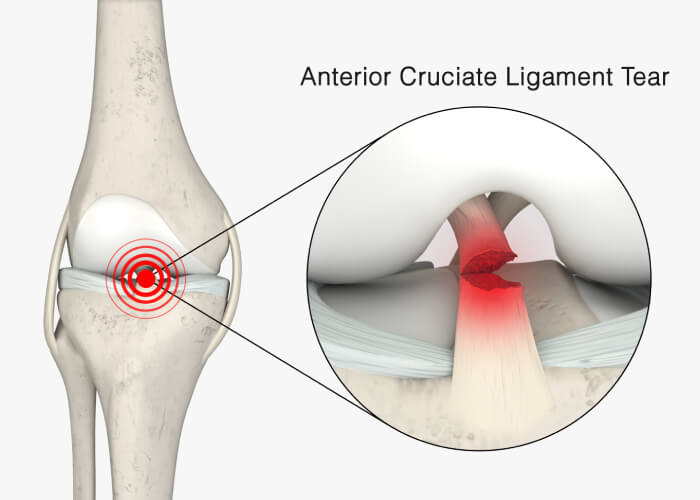
Causes
ACL injury occurs when:
- The player suddenly stops or lands awkwardly from a jump.
- A player sustains a high intensity impact on the side of the knee during a slide tackle.
- Repetitive turns and changing direction may cause studs to get caught in the turf and cause an ACL injury.
The most common symptoms of an ACL tear are swelling and severe pain. The knee can swell up within hours and the patient struggles to weight bear. A distinct pop sound after the injury is also indicative of ACL tear.
ACL Treatment
ACL injuries can put players out of action for several months. For mild cases, rehabilitation and physiotherapy are effective.
However, severe ACL tears require surgery followed by a period of rehabilitation and physiotherapy. This can often take as much as 6 months to a year before the player back to playing capacity.
MCL
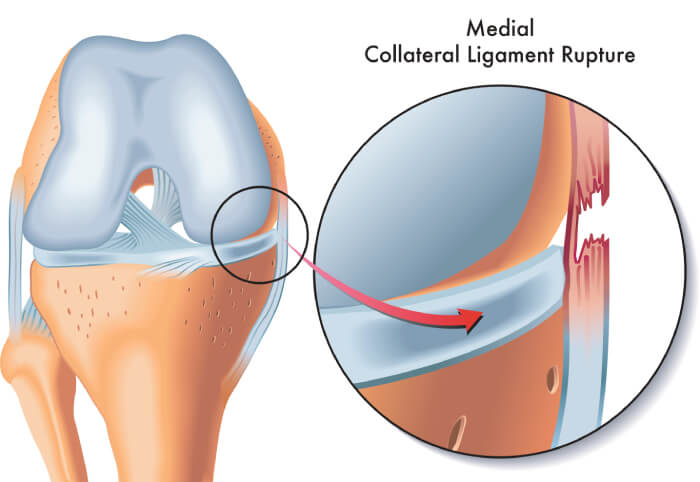
Medial collateral ligament (MCL) injury is another common football knee injury. Located on the inner side of the knee, the MCL connects the femur (thigh bone) to the tibia (shin bone). It prevents the tibia from overextending outwards and helps stabilise the joint. It also provides stability and strength to the knee joint.
MCL tears are common in people who participate in sports. Almost 40% of the knee injuries involve the MCL. MCL injuries happen due to a direct blow to the outside of the knee. Other causes for MCL injuries are:
- Sudden change in direction
- Twisting off the planted leg
The symptoms of an MCL injury are similar to an ACL injury. They may include:
- Swollen knee joint
- Locking or catching sensation in the knee joint
- Pain and tenderness on the inner side of the knee
MCL Treatment
Most MCL injuries in football players are not serious. Mild sprains do not require intervention except appropriate rest and physio. In addition, supportive knee braces can also aid in healing to a large extent. Players can be back on the field after 3-4 weeks of rest.
However, more severe tears cannot heal themselves and require surgical intervention, especially if the meniscus and ACL are affected.
Meniscus tear
Meniscus tears or torn cartilage are prevalent among sportspeople. The meniscus is a rubbery crescent-shaped cartilage sandwiched between the femur and tibia. It cushions the knee from the stress caused by running or walking. It also helps balance the knee. In this way the meniscus is termed the shock absorber of the knee
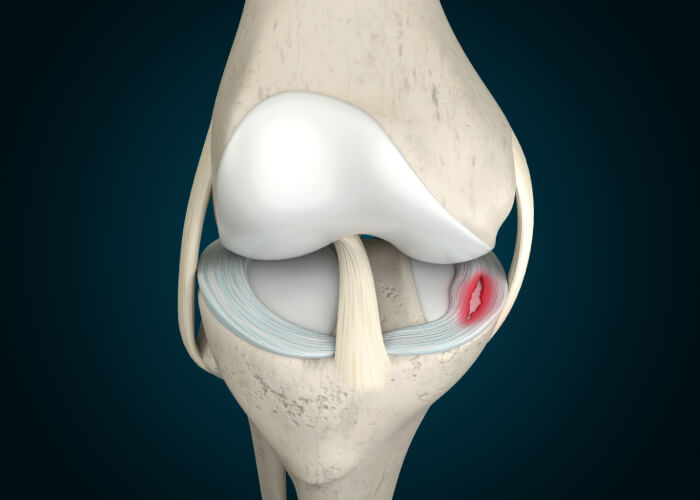
Much like MCL injury, meniscus tears also happen due to twisting the knee with your foot planted firmly.
The symptoms of knee meniscal tear include:
- Slight swelling and pain (minor cases)
- Severe pain
- Knee locking
- Stiffness
- Occasionally Unable to straighten the knee
Since the blood supply to the meniscus is poor, it doesn’t repair itself. In severe meniscus tears, players may require surgery and an extended period of physiotherapy.
In some cases, a part of the meniscus cartilage may even be removed. This procedure is called a meniscectomy.
Prolotherapy is also used in degenerative meniscus tears. This is a proliferate solution injected along several points of the meniscus and ligaments around the knee to help regenerate and add stability to the meniscus and ligaments in the knee.
Bucket Handle Meniscus Tear
An estimated 10% of all meniscus tears are bucket handle meniscus tears. A bucket handle tear is a unique type of meniscus tear where the whole meniscus tears and flips over. The torn part is then caught in the middle of the knee joint.
When this happens, occasionally the bucket handle tear will not allow the knee to straighten itself. This then becomes a ‘locked knee’ and a visit to the emergency department is required.
The symptoms of the bucket handle meniscus tear include:
- Significant swelling
- Bleeding at the knee joint
- inability to straighten the knee on occasion
Symptoms of Football Knee Injuries
Like any other sports injury, football knee injuries also cause pain and swelling, along with the feeling that your knees may be unstable. Often, the injuries are not as severe with only the collateral ligaments affected.
Ligaments are bands of tissue holding the bones together. In other cases, you may injure the other tissues surrounding the knee joint, especially the cartilage and tendons.
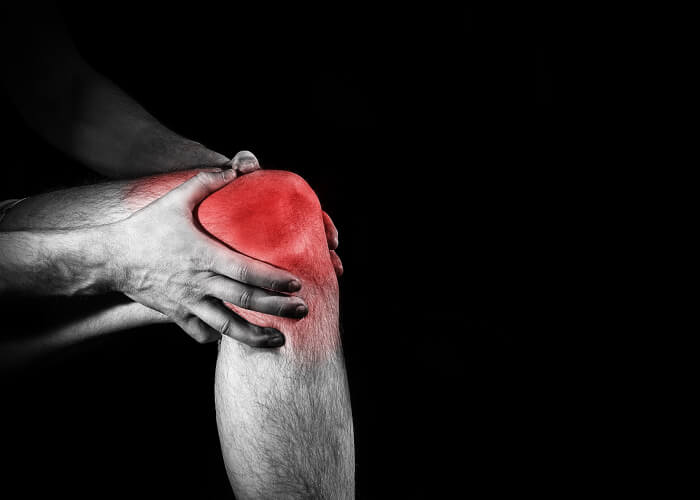
Final Words
Knee injuries are common in a footballer’s career. It is the one thing that a player fears the most. Being a high-intensity sport, football can be tough on the knees, and injuries often happen. However, in most cases, it is not the injury itself but a culmination of many factors, including a lack of stability and excess pressure on the knee joint.
If you feel knee pain after football, it is time you consult with a doctor and have the knee evaluated. Once a knee injury occurs, players are even more susceptible to future problems. It is therefore important to perform strengthening exercises along with flexibility and balance training to ensure a strong joint.
Frequently Asked Questions
How do I know if my knee injury is serious?
Signs of a severe knee injury include:
- Unable to bend or straighten the knee
- Sudden onset swelling within the joint
- Unable to bear weight.
How do you treat a knee injury from football?
Mild strains and sprains are treated with the RICE regime, which involves Rest, Ice, Compression and Elevation.
How long does it take to recover from a knee injury?
The healing time varies between 2 and 4 weeks for mild sprains and strains. However, in the case of major injuries such as ACL tears, it can take as much as 6-12 months.




